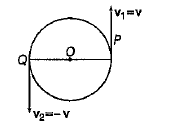A proton of mass 'm' moving with a speed v (<<c, velocity of light in vaccuum) completes a circular orbit in time 'T' in a uniform magnetic field. If the speed of the proton is increased to √2v, what will be time needed to complete the circular orbit?
√2T
T
T√2
T2
The correct Answer is:B
∴ The time period of the revolving charge is, T=2πRv=2πv×mvqBorT=2πmqB (Using r=mvqB)
Here T is independent of v. So there is no change in the time period of proton if speed is increased to √2v.
Topper's Solved these Questions
- MAGNETIC EFFECT OF CURRENTBOOK - MTG-WBJEECHAPTER - MAGNETIC EFFECT OF CURRENTEXERCISE - WB JEE Previous Years Questions
22 Videos
- LAWS OF MOTION BOOK - MTG-WBJEECHAPTER - LAWS OF MOTION EXERCISE - WB JEE PREVIOUS YEARS QUESTIONS (CATEGORY 3: ONE OR MORE THAN ONE OPTION CORRECT TYPE (2 MARKS))
2 Videos
- MAGNETICSBOOK - MTG-WBJEECHAPTER - MAGNETICSEXERCISE - WB JEE Previous Years Questions (Category 3: One or More than one Option)
2 Videos
Similar Questions
An electron moves in a circular orbit with a uniform speed v.It produces a magnetic field B at the centre of the circle. The radius of the circle is proportional to
View SolutionAn electron moves in a circular orbit with a uniform speed v.It produces a magnetic field B at the centre of the circle. The radius of the circle is proportional to
View Solution
Knowledge Check
A proton is moving perpendicular to the magnetic field with speed v and it is found that the proton takes T time to complete its circular path once. If the speed of the particle is increased to 2v, then how much time will it take to complete the circle?
ATBT/2C2TD4TAn electron moves in a circular orbit with a uniform speed v. It produces a magnetic field B at the centre of the circle. The radius of the circle is proportional to
ABvBvRC√vBD√BvAn electron moves in a circular orbit with a uniform speed v.It produces a magnetic field B at the centre of the circle. The radius of the circle is proportional to
ABvBvRC√vBD√Bv
A particle moves with constant speed v along a circular path of radius r and completes the circle in time T. The acceleration of the particle is
View SolutionThe orbital speed of an electron orbiting around the nucleus in a circular orbit of radius r is v. Then the magnetic dipole moment of the electron will be
View SolutionA proton is rotating along a circular path with kinetic energy K in a uniform magnetic field B. If the magnetic is made four times, the kinetic energy of rotation of proton is
View SolutionA particle moves with constant speed v along a circular path of radius r and completes the circle in time T. The acceleration of the particle is
View SolutionA particle is moving with a constant speed in a circular orbit. Find the change in its velocity when it completes half the revolution.

View Solution
